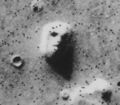Template:Selected anniversaries/October 21: Difference between revisions
No edit summary |
No edit summary |
||
| (2 intermediate revisions by the same user not shown) | |||
| Line 9: | Line 9: | ||
File:Nicolaus I Bernoulli.jpg|link=Nicolaus I Bernoulli (nonfiction)|1687: Mathematician and theorist [[Nicolaus I Bernoulli (nonfiction)|Nicolaus I Bernoulli]] born. Bernoulli will introduce a successful resolution to the [[St. Petersburg paradox (nonfiction)|St. Petersburg paradox]]. | File:Nicolaus I Bernoulli.jpg|link=Nicolaus I Bernoulli (nonfiction)|1687: Mathematician and theorist [[Nicolaus I Bernoulli (nonfiction)|Nicolaus I Bernoulli]] born. Bernoulli will introduce a successful resolution to the [[St. Petersburg paradox (nonfiction)|St. Petersburg paradox]]. | ||
||1788: George Combe born ... lawyer who turned to the promotion of phrenology and published several works on the subject. He followed Franz Josef Gall in Paris. Gall was a French physician who identified a number of areas on the surface of the head that he linked with specific localizations of cerebral functions and the underlying attributes of the human personality. Combe established the first infant school in Edinburgh and gave evening lectures. He studied the criminal classes and lunatic asylums wishing to reform them. Pic. | ||1788: George Combe born ... lawyer who turned to the promotion of phrenology and published several works on the subject. He followed Franz Josef Gall in Paris. Gall was a French physician who identified a number of areas on the surface of the head that he linked with specific localizations of cerebral functions and the underlying attributes of the human personality. Combe established the first infant school in Edinburgh and gave evening lectures. He studied the criminal classes and lunatic asylums wishing to reform them. Pic. | ||
| Line 40: | Line 38: | ||
||1921: Ingrid van Houten-Groeneveld born ... astronomer and academic. Pic. | ||1921: Ingrid van Houten-Groeneveld born ... astronomer and academic. Pic. | ||
||1926: André Jagendorf | André Jagendorf|link=André Jagendorf (nonfiction)|1926: Botanist and academic [[André Jagendorf (nonfictio)|André Jagendorf]] born. Jagendorf provided direct evidence that chloroplasts synthesize adenosine triphosphate (ATP) using the chemiosmotic mechanism proposed by Peter Mitchell. | ||
||1931: The Sakurakai, a secret society in the Imperial Japanese Army, launches an abortive coup d'état attempt. | ||1931: The Sakurakai, a secret society in the Imperial Japanese Army, launches an abortive coup d'état attempt. | ||
| Line 71: | Line 69: | ||
||2000: Dirk Jan Struik dies ... mathematician, historian of mathematics, and Marxian theoretician. Pic. | ||2000: Dirk Jan Struik dies ... mathematician, historian of mathematics, and Marxian theoretician. Pic. | ||
||2001: John H. Plumb dies ... historian known for his books on British 18th-century history. During the Second World War Plumb worked in the codebreaking department of the Foreign Office at Bletchley Park, Hut 8 & Hut 4; later Block B. He headed a section working on a German Naval hand cipher, Reservehandverfahren. Pic search. | |||
||2002: Bernhard Hermann Neumann dies ... mathematician who was a leader in the study of group theory. Pic. | ||2002: Bernhard Hermann Neumann dies ... mathematician who was a leader in the study of group theory. Pic. | ||
| Line 79: | Line 79: | ||
||2017: Gilbert Stork dies ... organic chemist and academic. ... known for making significant contributions to the total synthesis of natural products, including a life-long fascination with the synthesis of quinine. In so doing he also made a number of contributions to mechanistic understanding of reactions, and performed pioneering work on enamine chemistry, leading to development of the Stork enamine alkylation. Pic search. | ||2017: Gilbert Stork dies ... organic chemist and academic. ... known for making significant contributions to the total synthesis of natural products, including a life-long fascination with the synthesis of quinine. In so doing he also made a number of contributions to mechanistic understanding of reactions, and performed pioneering work on enamine chemistry, leading to development of the Stork enamine alkylation. Pic search. | ||
</gallery> | </gallery> | ||
Latest revision as of 06:12, 13 March 2022
1687: Mathematician and theorist Nicolaus I Bernoulli born. Bernoulli will introduce a successful resolution to the St. Petersburg paradox.
1914: Mathematics and science writer Martin Gardner born. His interests will include stage magic, scientific skepticism, philosophy, religion, and literature.
- André Jagendorf
1926: Botanist and academic André Jagendorf born. Jagendorf provided direct evidence that chloroplasts synthesize adenosine triphosphate (ATP) using the chemiosmotic mechanism proposed by Peter Mitchell.
1958: National Pareidolia Day declared in the United States.
1969: Mathematician and academic Wacław Sierpiński dies. He made important contributions to set theory (research on the axiom of choice and the continuum hypothesis), number theory, theory of functions, and topology.



